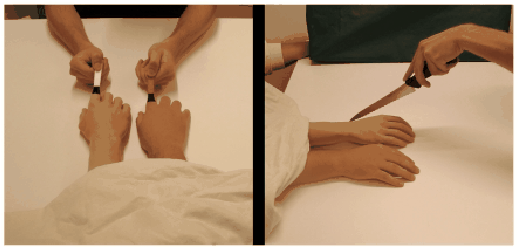
Next: Haptic interfaces Up: 13.1 Touch and Proprioception Previous: Haptic perception Contents Index
 |
Recall from Section 6.4 that the brain combines signals across multiple sensing modalities to provide a perceptual experience. Just as the McGurk effect uses mismatches between visual and auditory cues, illusions have also been discovered by mismatching cues between vision and somatosensory systems. The rubber hand illusion is one of the most widely known [67]. In this case, scientists conducted an experiment in which the subjects were seated at a table with both arms resting on it. The subjects' left arm was covered, but a substitute rubber forearm was placed nearby on the table and remained visible so that it appeared as if it were their own left arm. The experimenter stroked both the real and fake forearms with a paint brush to help build up visual and touch association with the fake forearm. Using a functional MRI scanner, scientists determined that the same parts of the brain are activated whether it is the real or fake forearm. Furthermore, they even learned that making a stabbing gesture with a needle causes anticipation of pain and the tendency to withdraw the real left arm, which was actually not threatened [67,298], and that hot or cold sensations can even be perceived by association [296].
More generally, this is called a body transfer illusion [255,298]. An example of this was shown in Figure 1.15 of Section 1.2 for a VR system in which men and women were convinced that they were swapping bodies, while the visual information from a camera was coupled with coordinated hand motions to provide tactile sensory stimulation. Applications of this phenomenon include empathy and helping amputees to overcome phantom limb sensations. This illusion also gives insights into the kinds of motor programs that might be learnable, as discussed in Sections 10.1 and 10.3, by controlling muscles while getting visual feedback from VR. It furthermore affects the perception of oneself in VR, which was discussed in Sections 10.4 and 12.2.
Steven M LaValle 2020-11-11